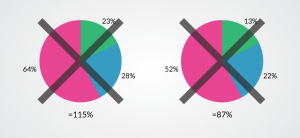Whether you run a traditional brick-and-mortar business or an eCommerce company based entirely online, a digital marketing strategy that yields results is a necessity.
After all, people can’t buy goods and services they don’t know about and have no opportunity to discover.
Your digital marketing efforts are the bridge between your company and an eager audience that’s sure to love what you have to offer.
But search engine algorithms, economic influences, and consumer tastes are constantly changing, so any good approach to digital marketing needs to perpetually evolve, as well.
That means reevaluating your goals every year to ensure they’re still in step with the times and current best practices.
The following digital marketing goals are musts for succeeding this year and beyond. Is your marketing team focused on the right things?
1. Ensure your digital marketing goals are SMART
Setting digital marketing goals that will get you where you want to be is about more than simply settling on the right things.
Good goals are also SMART goals, so you’ll want to make sure yours fit the bill.
S is for “specific”
Avoid setting vague goals without definable boundaries. For example, don’t just decide you want to attract more customers. What individual countries and regions do you want to focus on? What specific demographics are you looking to reach and why?
M is for “measurable”
Good goals are always quantifiable, giving you a reliable way to measure progress and know when your objectives have been met. Attach numbers and percentages to your goals to know what you’re shooting for.
A is for “achievable”
While it’s OK to be ambitious and aim high when it comes to your digital marketing goals, it’s crucial to ensure yours are still attainable. Ensure this is the case by basing new goals on your existing data. Goals should definitely be challenging but not spirit-crushing.
R is for “relevant”
Your ongoing digital marketing tactics should always align with your current set of long-term goals for your business. Review each new objective for relevancy before dedicating resources, time, and energy to it.
T is for “timely”
Again, there’s no room for vagueness when it comes to actionable digital marketing goals. Give each of your objectives a time-based deadline to ensure consistent success throughout every step of the process.
2. Prioritize personalization
People have always liked to feel they’re genuinely important to the businesses they buy from, but this has become increasingly crucial in the digital age.
Today’s consumers need and expect to feel they have a personal relationship with their favorite brands, and personalization is one very effective way to give this to them.
Roughly two-thirds of modern customers expect today’s companies to not only understand their individual needs but to cater to them.
Customers who get that tailored, highly personalized experience are much more likely to buy, as well.
Consider how you can better meet the expectations of your customers by:
- Personalizing outreach efforts to align with actual customer actions, like abandoned carts.
- Customizing email correspondence by reminding shoppers of products they’ve considered previously.
- Using unique messaging to welcome returning customers back to your website.
- Segmenting your email list according to factors like location, purchase time, browsing history, etc.
- Implement dynamic remarketing strategies to nudge indecisive customers toward a purchase.
3. Make the switch to first-party data
Today’s consumers and web users are no longer in the dark about just how much data their favorite websites, social media platforms, and eCommerce stores collect.
They care how their data is used, and they’re increasingly concerned about their privacy, so third-party data use is officially on its way out.
Firefox and Safari already no longer allow the use of website cookies, and Google is set to follow suit in 2023.
That means a cookieless future isn’t just a pipe dream anymore. It’s already here, and soon it will be your only option as a marketer.
So start leveraging your own first-party data now to gain deeper insight into your customers’ behavior and set appropriate digital marketing goals.
4. Boost engagement with short-form social media videos
It’s no secret that video has been red hot in marketing for a while now.
It’s not hard to see why, either. Video is fun, dynamic, and easy to consume.
It’s also increasingly popular across today’s evolving social media landscape, especially when it comes to bite-sized options like TikTok videos, YouTube Shorts, and Instagram Reels.
Shortform social media video isn’t just something younger demographics are into these days, either. Older demographics are developing an interest in snackable video content, as well, so it’s something any smart marketer should consider.
Choose the best platform for your brand by considering who your customers are and what they’re into. If you’re looking to tap into the under-30 market, then TikTok is the place to be.
Meanwhile, Instagram boasts a much more varied audience, including many users in their 30s, 40s, and above.
Consider truly original ways your brand can leverage the short-form video trend to better connect with your existing or potential audience.
5. Implement machine learning to understand your data better
Remember, the further the world of digital marketing goals moves away from the third-party data it used to count on, the more important your valuable first-party data will become.
But it’s essential to have a solid plan for not only collecting your data but organizing and analyzing it. That’s where the right machine-learning solutions can be a godsend.
Machine learning is all about using AI to “teach” systems how to improve without the need for direct intervention from human teams (as with programming).
We already see machine learning at work in examples like Google’s conversion maximization strategy, so consider starting there.
But keep your eyes peeled for even more ways machine learning can help you streamline your digital marketing goals this year.
6. Get on board with Metaverse marketing
Facebook may still be the first name that comes to mind when you hear the term “metaverse marketing” at this point, but it’s essential to understand that this up-and-coming concept is about so much more than that.
Metaverse marketing on a larger scale also encompasses emerging options like augmented reality, virtual reality, 3D avatars, virtual events, and so forth.
Although the metaverse is still in its growth phase, it’s no longer a matter of if it will eventually catch on. It’s about when, so it would be wise to add the implementation of a metaverse-oriented strategy to your ongoing list of digital marketing goals.
Early adopters who master this now will have a significant advantage once it becomes more mainstream.
7. Integrate solution awareness into your marketing messages
One of the best ways to get through to modern consumers is to set digital marketing goals that embrace the way people research purchase decisions these days.
They start their journey knowing they’re looking for something, but not being entirely sure what. From there, they gradually identify their exact problem right before actively searching for solutions to it.
This year, look for ways to leverage both problem awareness and solution awareness in your digital marketing strategies.
Be sure to include content aimed at customers in both stages of that process.
Help them give their problem a name. Then, show them how your company can help by equipping them with the dynamic solutions they need.
8. Work on creating better brand awareness
Getting ahead is about more than simply moving products and generating increased interest in your services.
Modern consumers aren’t interested in making one-off purchases from brands to which they feel no particular connection.
They want to spend their money in ways that make them part of something larger than themselves, so building brand awareness is key.
Set digital marketing goals that effectively leverage social media, interactive content, and more to get your brand in front of the right eye.
Brainstorm creative ways to give your brand a story and a voice, as well as to set them apart from the rest of what’s out there.
Keep track of what your competitors are doing, too. What can your brand do for your target audience that the other guys can’t? What makes your company unique in all the right ways?
9. Establish your company as an industry authority
These days, there isn’t much difference between how consumers view the brands they follow and how they view their individual contacts.
They expect intimate, personal relationships with both. They expect to be equally entertained, considered, and prioritized by both, as well.
Trust is a crucial element in such relationships, so make sure your digital marketing goals include a strategy for improving your authority cred within your industry or niche.
Naturally, that means creating plenty of search engine-optimized content that caters to customers at every stage of your marketing funnel.
However, it also means connecting with other industry authorities and peers. Look for opportunities to contribute high-caliber content to other high-ranking sites in your niche.
Partner with key influencers within your industry. And reinforce business-customer relationships by being responsive to your audience when they go out of their way to engage with you.
Wrap Up
Even the best, most creative digital marketing goals need to be rooted in data if they’re going to get you where you need to be.
Data-driven marketing isn’t just about consulting the numbers before launching a new campaign or updating an existing one. It’s also essential to know how to merge this year’s marketing standards with what you already know about your customers.
Take a look at our comprehensive guide to the key pillars of data-driven marketing today for an overview of what you need to know.
You’ll learn about the emerging role of AI in the marketing industry, discover how to apply powerful storytelling techniques to your data analysis efforts, and more!




![[ROCK NA] [EBOOK SEO] Complete Guide](https://rockcontent.com/wp-content/uploads/2024/06/banner_Search-Engine-Optimization.png)






